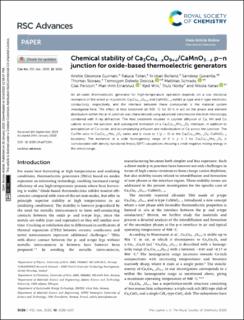Chemical stability of Ca3Co4−xO9+δ/CaMnO3−δ p–n junction for oxide-based thermoelectric generators
Gunnæs, Anette Eleonora; Tofan, Raluca; Berland, Kristian; Gorantla, Sandeep Madhukar; Storaas, Thomas Aarflot; Desissa, Temesgen Debelo; Schrade, Matthias; Persson, Clas; Einarsrud, Mari-Ann; Wiik, Kjell; Norby, Truls Eivind; Kanas, Nikola
Peer reviewed, Journal article
Published version

Åpne
Permanent lenke
https://hdl.handle.net/11250/2677595Utgivelsesdato
2020Metadata
Vis full innførselSamlinger
- Institutt for materialteknologi [2545]
- Publikasjoner fra CRIStin - NTNU [38070]
Sammendrag
An all-oxide thermoelectric generator for high-temperature operation depends on a low electrical resistance of the direct p–n junction. Ca3Co4−xO9+δ and CaMnO3−δ exhibit p-type and n-type electronic conductivity, respectively, and the interface between these compounds is the material system investigated here. The effect of heat treatment (at 900 °C for 10 h in air) on the phase and element distribution within this p–n junction was characterized using advanced transmission electron microscopy combined with X-ray diffraction. The heat treatment resulted in counter diffusion of Ca, Mn and Co cations across the junction, and subsequent formation of a Ca3Co1+yMn1−yO6 interlayer, in addition to precipitation of Co-oxide, and accompanying diffusion and redistribution of Ca across the junction. The Co/Mn ratio in Ca3Co1+yMn1−yO6 varies and is close to 1 (y = 0) at the Ca3Co1+yMn1−yO6–CaMnO3−δ boundary. The existence of a wide homogeneity range of 0 ≤ y ≤ 1 for Ca3Co1+yMn1−yO6 is corroborated with density functional theory (DFT) calculations showing a small negative mixing energy in the whole range.
